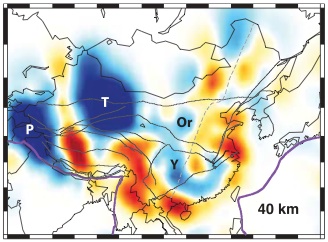| Home |
| Research |
| Downloads |
| Publications |
| Teaching |
| People |
| Press |
| Allen CV |
| Seismo Lab |
| Earth & Planetary |
| UC Berkeley |
|
Shear wave tomography of China using joint inversion of body and surface wave constraints |
|
Mathias Obrebski
J. Geophys. Res., 117 B01311,
Download a preprint:
ObrebskiEtAlChinaJGR2012.pdf
|

S-velocity structure at 40km depth beneath China. |
Abstract
The India-Eurasia collision and the decratonization of the North China Craton have drawn much attention from the scientific community. Here we provide the first large-scale S wave velocity model for China (CH11-S) based on constraints from both teleseismic surface and body waves. We take advantage of the recent deployment of the 140 permanent stations of the Chinese Digital Seismic Network and temporary network deployments to resolve both the lithospheric and deeper mantle structure. Slow velocities are widespread in the crust and upper mantle. Deeply rooted fast anomalies are located beneath the stable Yangtze Craton and the western (Ordos) block of the North China Craton. An upper mantle fast anomaly is observed beneath the eastern block of the North China Craton and
could represent thermally eroded or delaminated Precambrian lithosphere. Another flat and fast feature appears beneath the Tibetan Plateau from 50 to 250 km depth. This may represent the Indian slab stalled in the mantle due to its buoyancy or a lithospheric instability triggered by the India-Eurasia collision. A large fast anomaly apparently stagnant in the transition zone is observed beneath the Yangtze Craton and may play a role in the stability of this block. In contrast, on both sides of the South China Block, active and reactivated areas coincide with oceanic slab material that has already sunk into the lower mantle and that may have enhanced tectonic activity by forcing convection. Finally, the upper mantle beneath Tibet seems almost completely surrounded by adjacent high-velocity and presumably strong blocks.
